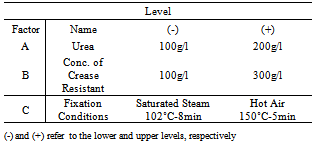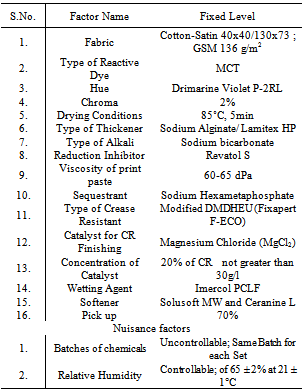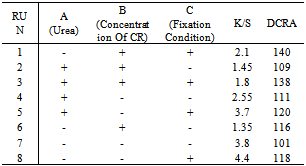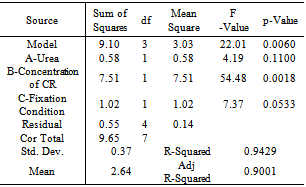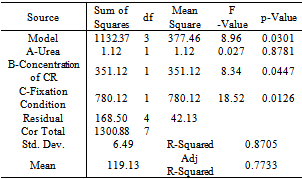-
Paper Information
- Next Paper
- Previous Paper
- Paper Submission
-
Journal Information
- About This Journal
- Editorial Board
- Current Issue
- Archive
- Author Guidelines
- Contact Us
International Journal of Textile Science
p-ISSN: 2325-0119 e-ISSN: 2325-0100
2013; 2(1): 7-11
doi:10.5923/j.textile.20130201.02
Effects of Process Parameters on Single Step Fixation of Reactive Printing and Crease Resistance Finishing of Cotton Fabrics using 23 Factorial Design
Fareha Asim1, Muzzaffar Mahmood2
1Department of Textile Engineering NED University of Engineering & Technology Karachi, Pakistan
2Department of Mechanical Engineering NED University of Engineering & Technology Karachi, Pakistan
Correspondence to: Fareha Asim, Department of Textile Engineering NED University of Engineering & Technology Karachi, Pakistan.
| Email: |  |
Copyright © 2012 Scientific & Academic Publishing. All Rights Reserved.
Effects of process parameters on single step fixation for reactive printing and crease resistance finishing of cotton fabric has been investigated in this research work using factorial design. 23 factorial design have been designed and conducted to check the effect of concentration of crease resistant, urea and time-temperature profile of fixation conditions on the single step fixation process of reactive printing and crease resistance finishing. The results from the experiment suggest that two out of three factors were significant, which are concentration of crease resistant and fixation condition. Evaluation of the single step fixation process in comparison to the two-step combination has been made with respect to k/s value and dry crease recovery angle (DCRA) using software Design Expert 7.0. The statistical and graphical analyses of experiment revealed the significant effect of concentration of crease resistant and fixation condition on the response variables of single step fixation process. Furthermore, the models have been tested for adequacy and found that the assumption of normality and independency are not violated. R2 values were very high, suggesting that models accounted for most of the variability.
Keywords: Crease Resistance Finishing, DOE, DCRA, Factorial design, k/s, Reactive Printing, R2
Cite this paper: Fareha Asim, Muzzaffar Mahmood, Effects of Process Parameters on Single Step Fixation of Reactive Printing and Crease Resistance Finishing of Cotton Fabrics using 23 Factorial Design, International Journal of Textile Science, Vol. 2 No. 1, 2013, pp. 7-11. doi: 10.5923/j.textile.20130201.02.
Article Outline
1. Introduction
- Cotton is an important fibre in textiles, because of its numerous advantages which need no explanation. One of the main disadvantages of cotton is creasing after washing[1]. On creasing the cotton fabrics, the molecular chains in the amorphous region slip past each other, breaking the weak hydrogen bonds. The stretched chains then form hydrogen bonds in the stretched places and thus the fabric holds the creases. The mechanism of the crease recovery process in cotton fibres is based on introducing stable cross-links so as to prevent slippage of molecular chains[2].Cotton fabric is usually printed with reactive dyes of low reactivity, mainly Monochlorotriazine (MCT), since these dyes exhibit high solubility, low affinity, high diffusion and high print paste stability. Printing of cotton fabric with these kinds of dyes offers the following advantages: minimum hydrolysis of the dyes during the printing process, maximum fixation on cotton fabrics, minimum staining on white grounds during the washing off process and good all-round fastness properties of the print[3].The current procedure for printing and crease resistant finishing of cotton fabric involves the application of two processes separately and in succession. The present research work was undertaken with a view to exploring the feasibility of carrying out single step fixation of reactive printing and crease resistance finishing of cotton fabric and to investigate the effects of process parameters on single step fixation of reactive printing and crease resistance finishing of cotton fabric using design of experiment (DOE). An extensive literature review had been conducted for the identification of key factors which were systematically examined through 23 factorial design.
2. Experimental
- After a critical study of reactive printing and crease resistance finishing processes[4-21] a pre-experimental plan was developed. The 23 factorial design were conducted to examine the significant factors affecting the single step fixation process. Potential design factors, held constant factors, nuisance factors, response variables and experiment design for the single step fixation process were outlined. The particulars of the plan are given in Table 1 and 2. The values at (-) and (+) levels of various factors were chosen based on standard practices followed in textile industry.
2.1. Pre experimental plan
2.1.1. Process Route
- Initially two routes were examined for carrying out the single step fixation process for reactive printing and crease resistance finishing. The process followed in both routes is as follows;Route 1Crease Resistance Finish-Dry-Reactive Print-Dry-Fix- Wash-DryRoute 2 Reactive Print-Dry-Crease Resistance Finish -Dry-Fix- Wash-Dry
2.2. Findings
- It was found that in the case of Route 2 after application of print paste and drying when fabric was immersed in the liquor containing crease resistant and auxiliaries, the print bleeds and loses its localization. Therefore, Route 1 has been selected for the single step fixation process.
2.3. Experiment Design
- Design of experiment (DOE) is a standard statistical technique to identify key factors and levels that influence system performance and variability. This technique is especially useful when there is the need to understand the interactions and effects of several system variables and an absence of concrete information[22]. The supplemental text material for DOE may be found in[23]. 23 factorial design was used to investigate the effect of process parameters namely: (i) Urea, (ii) concentration of crease resistant, (iii) fixation Conditions on single step fixation of reactive printing and crease resistance finishing. A 23 two-level factorial design of 8 trials with two repetitions was run according to the design matrix in Table 3. The experiments were performed in random order. The results were analyzed using software Design Expert 7.0. The responses investigated were the colour yield and dry crease recovery angle (DCRA). The details of the experimental design arrangement are shown in Tables 1, 2 and 3.
2.4. Evaluation of Response Variables
|
|
2.4.1. Color Yield Measurement
- Color yield of print-finish fabrics were assessed spectrophotometrically and expressed in terms of the Kubelka-Munk (k/s) relationship. The condition for measurement was set under specular excluded with large aperture. The fabric was folded twice to ensure opacity. The k/s was calculated according to Equation 1:
 | (1) |
2.4.2. Evaluation of Dry Crease Recovery Angle
|
|
|
3. Results and Discussion
- The results from the experiment suggest that two out of three factors were significant to the response variables of single step fixation process. The significant factors are concentration of crease resistant and fixation conditions. The experimental results, ANOVA for k/s and DCRA are shown in Table 3, 4 and 5 respectively.
3.1. Assessment of the Significant Factors in Single Step Process
3.1.1. Influence of Concentration of Crease Resistant
- The main factor plots of concentration of crease resistant are shown in Figure 1 and 2. Figure 1 showed that as the concentration of crease resistant increases, k/s decreases keeping other factors at average values. This was probably due to the limited number of reactive sites on cotton for reactive dye and crease resistant. As the concentration of crease resistant increases without increasing the concentration of dye the cross linking of crease resistant to cotton site will increase and hence less number of sites will be available for reactive dye, hence k/s decreases. Figure 2 supports this view. DCRA increases with the increase in concentration of crease resistant, keeping other factors at average values. This was expected as more crease resistant being cross linked to increase the crease recovery properties of fabric.
3.1.2. Influence of Fixation Conditions
- The main factor plot of fixation conditions is shown in Figure 3. The plot of fixation condition showed that the dry crease recovery angle attained the maximum value for the curing mode of fixation as compared to steaming. This was highly probable because crosslinking of crease resistant is favourably happen in dry heat as compared to moist heat.
3.2. Influence of Urea
- Though concentration of urea was not identified as a significant model term but the visual analysis of fabric samples showed that, in curing samples treated with 200 g/kg of urea were brighter than samples treated with 100 g/kg of urea. However, in steaming a high concentration of urea gives blurring of sharp boundaries of print design.
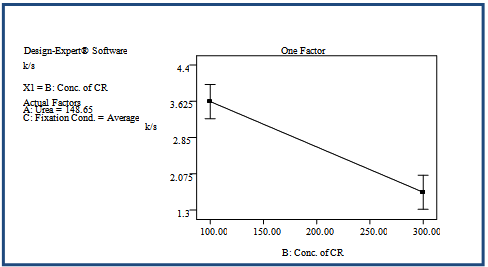 | Figure 1. Effect of concentration of crease resistant on k/s values |
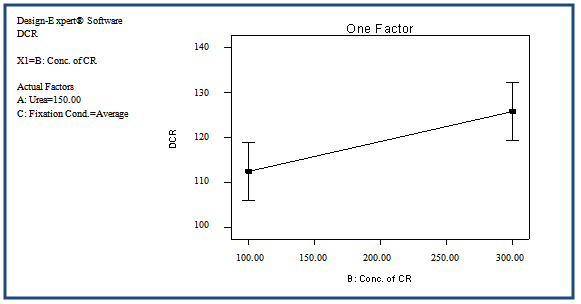 | Figure 2. Effect of concentration of crease resistant on DCRA values |
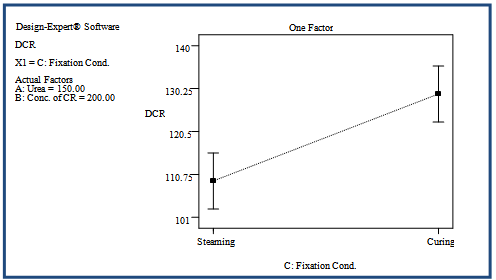 | Figure 3. Effect of fixation condition on DCRA values |
4. Conclusions
- 23 factorial design has been used to investigate the effect of process parameters urea, concentration of crease resistant and fixation condition on the single step fixation of reactive printing and crease resistance finishing of cotton fabric. From the statistical and graphical analyses, it was found that concentration of crease resistant and fixation conditions are significant to the considered response variables namely colour yield and dry crease recovery angle of the single step fixation process.Furthermore, the uncertainty analyses for measurements show that the predicted values are in good agreement with experimental data and are sufficiently accurate. R2 values were very high, suggesting that models accounted for most of the variability. Most of all single step fixation of reactive printing and crease resistance finishing processes offers potential benefit to the textile wet processing sector. The economic benefits include saving energy, labor and machine occupation time by shortening the process route, and increase in productivity, reduction in lead time and expectedly reducing the cost of finished fabric.
ACKNOWLEDGEMENTS
- The authors acknowledge the permission given by Gul Ahmed Textile Mills Ltd, for carrying out the necessary experimental work
 Abstract
Abstract Reference
Reference Full-Text PDF
Full-Text PDF Full-text HTML
Full-text HTML